
Ninots and Ninot Exhibition
The satirical figures that make up the fallas and how they become Ninots Indultats, saved from the flames by the public’s vote
Ninots and the Ninot Exhibition in a nutshell…
Ninots are the satirical figures that form part of the larger Fallas sculptures. Each year, nearly 800 compete in the Exposició del Ninot for the chance to be saved from the flames by public vote. The winners become Ninots Indultats and are displayed in the Museu Faller.
Location: Museo de Ciencias Príncipe Felipe, City of Arts and Sciences, Valencia
Dates: Early February to March 14 (children’s ninots), March 15 (adult ninots)
Entry Fee: Adults €3, Children (4-12) €1.50, Free for children under 4
Ninots are the free-standing figures that are part of a bigger falla composition. The word itself is Valencian for doll. These carefully-designed and painted sculptures are made with the intent to represent a character that relates to or exemplifies the larger theme of their falla.
Ninots, much like the fallas they are part of, can be adult ninots - therefore dealing with political and social themes apt for grownups - or ninots infantiles - made to be appealing to children.
Every year, almost 800 ninots (half for adults, half for kids) are displayed in an exhibition, called the Exposició del Ninot . The purpose of this event is to have the public elect their favourite figures, which will become Ninots Indultats. These are the sculptures that will be saved from the fire of the Cremà.
Now, if you really want to understand the spirit in which the ninots are made, it’s important to keep something in mind. Even though the aim of the exhibition is to choose the Ninots Indultats, the point of the sculptures, much like the point of the fallas, is always to burn. They are built with the intent to surprise, astound, and delight the public as statues, and then do it all over again as they burn.

The ceremony of electing pardoned ninots arises from a wanting to canonise the habit of keeping a few sculptures as a memento. It does not mean that the artists ever make the ninots to save them from the flames. Such a figure would surely be a work of art, but never part of a falla.
What’s a Ninot
It’s important to point out that the term ninot is not interchangeable with the term falla. While the latter is a complete monumental composition representing a scene, the former is a figure that is part of said scene.
Ninot is in fact Valencian for doll. It is an individual, free-standing figure, usually in the shape of a popular character or famous person. This is often with satirical intent over current socio-cultural or political events. These figures are designed and built by the same artists that build the rest of the fallas.
Normally, ninots are burned during the Cremà with the rest of the falla monuments they are part of. However, every year, an exhibit is held in which some ninots are pardoned from the fire because of their artistic value and their success with the public.
Origins
The ninots’ origins (and consequently those of the fallas themselves) bring us back a few centuries. Back then, on the occasion of Saint Joseph’s day, Valencian carpenters used to burn the lanterns they wouldn’t need in the upcoming spring and summer days.

The workers used to set up their parots (the lantern poles used to illuminate their workshops in the winter months) in the street, surround them with the wood shavings they didn’t need, and burn everything.
Over the years, carpenters started getting creative with their compositions, dressing the parots in such a way that they would satirically resemble local celebrities or members of the ruling class. The parots thus became ninots (meaning doll, in Valencian).
Materials
Ninots were initially wax and wooden dummies dressed up with fabric scraps or old clothes. Over time, the techniques and materials changed, allowing for the typically expressive and exaggerated features and postures to be added.
In the 1950s, the ninots were created from processed cardboard and papier-mâché. In the 1960s polyester became popular and in the 1980s it started being replaced by expanded polystyrene.
Nowadays, artists try to experiment and use more environmentally-friendly materials, but the bigger and more voluminous ninots are still made of expanded polystyrene (also called white cork), as it is extremely lightweight and durable.
The Exhibit and the Ninots Indultats
The Exposició del Ninot (Ninot Exhibition in English) is a ninots show, whose aim it is to determine the Ninots Indultats of the year. Every Fallas committee sends two of their ninots (one adult sculpture and one ninot infantil) to the Exposició held at the Museo de Ciencias Príncipe Felip in the City of Arts and Sciences.
The exhibition is open from early February to mid-March, allowing the public and the JCF to admire the sculptures which best represent their fallas of origin. In the end, votes are counted and the Ninots Indultats are declared.
Opening Hours
| Days |
|---|
| Opening hours |
Prices
| Age |
|---|
| Price |
Ninots Indultats
A Ninot Indultat is a pardoned ninot, meaning it has been spared from the fire of the Cremà by popular vote. Each year, following the Exposició del Ninot, two ninots in all of Valencia are awarded this title. One of them is an adult ninot (usually political or mature and satirical), the other one is a ninot infantil (for kids). After the Exposició, the ninots that have not been chosen, are returned to their fallas, to be burnt with them in the fire of the Cremà.

However, Ninots Indultats are not the only ones that don’t end up in flames. It is customary for Falleras Mayores and committee presidents to keep some of the ninots for themselves. The Fallas Artists Guild can also decide to keep some of the ninots for their outstanding artistic value. These ones will be exposed in the Museo del Gremio Artesano de Artistas Falleros, while the Ninots Indultats by popular vote are all exposed in the Museu Faller.
History of the Exposició
The Exposició del Ninot, as it is called in Valencian, was conceived by a Fallas artist. His proposal also included a parade to the exhibition centre (which has today become the Cabalgata del Ninot) and a parade back to the Museu Faller for the winning ninots.
1933 - Valencia City Council wants to introduce new events
Valencia’s City Council announced a competition of ideas to create events for the upcomingFallas. Fallas artist Regino Mas won with his proposal: L’Indult del Foc, which roughly translates to Pardoned from the Fire.
1934 - 1936 - Mercat Central
The exhibition was first held in 1934, and it took place in the Mercat Central’s basement for the first three editions.
1940 - 1996 - Lonja de la Seda
The Exhibition changed venues, going to the Lonja de la Seda for several years.
1997 - 2000 - Mercado Central
The Exhibit briefly returned to the Mercado Central.
2001 - 2003 - Mercado de Russafa
The Ninot Exhibit was moved for a few editions to the Mercado de Russafa.
2004 - 2015 - Nuevo Centro
For several editions, the shopping centre Nuevo Centro, in front of the Turia Park was home to the Exhibition.
2016 - present - Príncipe Felipe Science Museum
Finally, in 2016, the Exhibit started being held in the Museo de Ciencias Príncipe Felip in the City of Arts and Sciences, where it is still hosted every year.
The Contest
The system for choosing which will be the Ninots Indultats is really very simple. Anyone who visits the Exposició del Ninot - which costs only a few euros to get in - can vote for their favourite ninots.
At the end of the exhibit, the ninots that have received the most votes (one ninot infantil and one adult ninots) will be saved from the flames and taken to the Museu Faller. The winners are declared on the 14th of March for the children’s ninots, and on the 15th of March for the adults’ ninots.
This popular vote system is unique in its kind. As far as methods for incorporating pieces into a museum go, no other institution chooses its pieces this way.
Recogida del Ninot
The Recogida del Ninot is the act of bringing the ninots that have not become Ninots Indultats back to their casal fallero of origin. This is one of the most unknown ceremonies of the festival, yet one of the most festive and upbeat events.
Right after the Ninots Indultats are announced (on the 14th of March for ninots infantiles and on the 15th for adult ninots), hundreds of falleros, falleras and music bands gather outside the Ninot Exhibition. It’s not unusual to see tabalets and dolçainas being played.

One by one, among the singing, dancing, and music, they will collect their committee’s ninots and bring them back to their casal. To get there, they will use vans, buses, or even tractors, all decorated with balloons, flags and Fallas-themed ornaments. In tone with the rest of the ceremony, this is also done as loudly and as festively as possible.
Frequently Asked Questions
Here you can find quick answers to all of your questions. Linked, you’ll find the articles or the sections of the articles that can give you more detailed information.
-
A ninot is a figure that is part of a falla scene. It is an individual, free-standing satirical figure, usually in the shape of a popular character or famous person.
-
A Ninot Indultat is a pardoned ninot, meaning it has been spared from the fire of the Cremà by popular vote.
-
Every year, two Ninots Indultats are elected by popular vote. But these are not the only ninots that will be spared from the fire.
It is customary for Falleras Mayores, committee presidents, and the Fallas Artists Guild to keep some of the ninots for themselves or to display them in the Museo del Gremio Artesano de Artistas Falleros.
-
The Ninots Indultats chosen by popular vote are displayed in the Museo Faller.
-
The Ninots Indultats are chosen by popular vote. Anyone who goes to see the Exposició del Ninot can vote.
You can learn more about the selection process in the relevant section of this article.
-
The Exposició del Ninot is currently held in the Museo de Ciencias Príncipe Felip in the City of Arts and Sciences.
-
The Exposició del Ninot is the exhibition in which the Ninots Indultats are chosen.
-
The Exposició del Ninot was first put up in 1934.
You can learn more about its origins and the Fallas artist that came up with the idea in the relevant section of this article.
-
The Recogida del Ninot is the act of bringing the ninots that have not become Ninots Indultats back to their casal fallero of origin. This is a very festive, loud, and cheerful event, albeit lesser well-known than other Fallas events.
You can learn more about it in the relevant section of this article.
-
The Museu Faller is where all the Ninots Indultats (since 1934) are held.
-
The Museo del Gremio Artesano de Artistas Falleros is where the ninots chosen (and saved from the fire) by the Fallas Artists Guild for their artistic value are held.



















